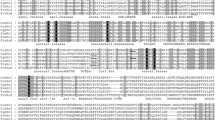Abstract
Phylogenetic analysis of the prophenoloxidase/hexamerin family of arthropods revealed four well supported subfamilies: (1) the arylphorin subfamily, including arylphorins, storage proteins, and other proteins of uncertain function from insects; (2) the hemocyanins of branchiopod crustaceans, which are copper-binding proteins involved in oxygen transport; (3) the hemocyanins of chelicerates; and (4) the prophenoloxidases (proPO) of both insects and branchiopods, which are copper-binding molecules that play a role in sclerotization of cuticle and encapsulation of foreign particles. The phylogeny indicated that insect and branchiopod proPO constitute a monophyletic group but that branchiopod and chelicerate hemocyanins do not constitute a monophyletic group. Branchiopod hemocyanin and proPO diverged from each other prior to the divergence of insects from branchiopods and probably prior to the divergence of chelicerates from the insect-branchiopod lineage. Likewise, the insect arylphorin subfamily diverged from proPO prior to the divergence of insects from branchiopods and probably prior to the divergence of chelicerates; thus, the results did not support the hypothesis that insect arylphorins represent hemocyanins freed to assume a new function because the insect tracheal respiratory system removes the need for an oxygen-transport molecule. Nonetheless, reconstruction of ancestral sequences by the maximum parsimony method suggested that the ancestors of the arylphorin family were copper-binding. Regions corresponding to the copper-binding domains were found to have a faster rate of nonsynonymous evolution in arylphorin subfamily genes than in other hexamerin family genes; this presumably reflects a relaxation of purifying selection after the loss of copper-binding function.
Similar content being viewed by others
Author information
Authors and Affiliations
Additional information
Received: 25 March 1998 / Revised: 3 July 1998
Rights and permissions
About this article
Cite this article
Hughes, A. Evolution of the arthropod prophenoloxidase/hexamerin protein family. Immunogenetics 49, 106–114 (1999). https://doi.org/10.1007/s002510050469
Issue Date:
DOI: https://doi.org/10.1007/s002510050469




